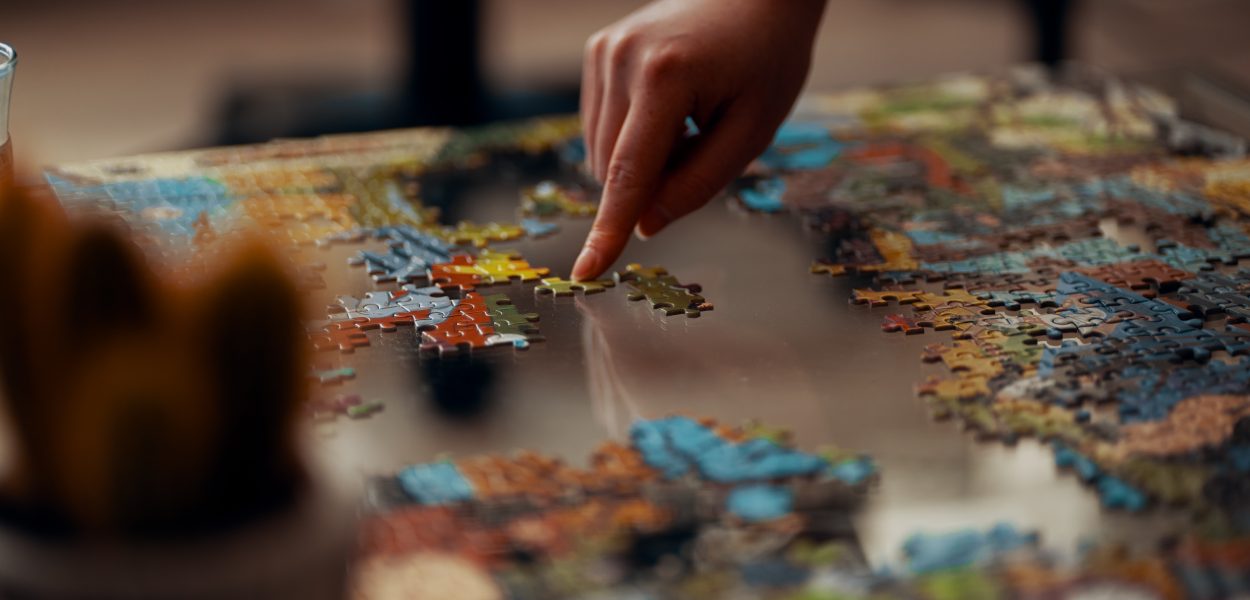11 February 2021
7 life lessons I have learnt from jig-saw puzzles
Posted in Family Space / Parents & Carers / SU QLD / Teens and Young Adults
An unfinished jig-saw puzzle has always sat on the table at my parent’s house. When we visit, it doesn’t take long before we are gathered around the table, absorbed in the emerging picture, examining the puzzle pieces and trying to match them and fill the available gaps.
My father and mother had a very practical approach to teaching their six kids important life skills. They rarely ‘lectured’ or ‘preached’, rather they excelled at finding aspects of activities or situations where they could get us thinking about what we could learn from what we were doing.
Thanks to the hundreds of jig-saw puzzles we have done over the years, I’ve learned a lot about problem solving. In fact, I’ve used these learnings as ‘guide posts’ to help me meet the challenges I have encountered in life.
So today, I would love to share these insights with you in the hope that you’ll find these helpful when facing your own challenges.
1. Start with the end in mind.
Most jig-saw puzzles come in a box that shows a picture of what the finished product will look like. There is a clear goal we are working towards. If we know what we are trying to achieve, it is easier to map out steps to achieve the goal. It is important to keep looking back at the picture – to see where the parts fit into the whole.
2. Put boundaries in place.
When doing a puzzle, we usually start with the edge pieces. This sets the boundaries around the project. It is important to be clear about boundaries, what is in, what is out, what is my responsibility, what is not, what is within my control, what is not!
3. Only bite off what you can chew.
The biggest puzzle I have done was 1500 pieces, the smallest was eight pieces. There are factors to consider in choosing the size of the puzzle. It is important to assess your environment, your ability and the resources you have available before making a decision. While there is limited fun to be found in an eight-piece puzzle, starting a 500-piece puzzle over a 30-minute lunch at McDonalds is just silly!
4. Match your approach to your situation.
Different parts of the puzzle benefit from different approaches. Sometimes matching colours is the best strategy, or matching shapes, or sometimes trial and error is the only way! Trial and error is the most time consuming and least rewarding. It’s really a last resort.
5. Celebrate your successes.
We tend to start with the edge, then the sections of the puzzle that will be the easiest. The flowers of the field with their varying colours and shapes are formed fairly quickly under our busy hands. We stop often to admire our achievement and happily chatter away. Then we come to a solid block of blue sky only discolored by the occasional puff of white cloud. Nerves become more frazzled as the tedious ‘trial and error’ method must be employed, we celebrate our successes with an exclamation of ‘got a piece in’ which, when the going is slow, warrants a cheer and congratulations.
6. Start with what you can do, not what you can’t.
With a puzzle one tends to work on patches that seem easy. If you are stuck, move to a different part or simply look at what you are working on from a different angle. Sometimes it is best to put the puzzle on hold and come back afresh.
7. Know when to walk away.
This last ‘lesson’ is one that I have found particularly difficult. Recently, for the first time ever, we actually gave up on a puzzle. We pulled apart what we had done and put it back in the box. After many hours working on it my mother and I made a decision that it was just not worth continuing. As we solemnly packed it away, we reflected on times when we have pushed forward in what we thought was perseverance when time showed it to have been simply obstinance. While never giving up is a great catch cry, sometimes the struggle and fall out of continuing is simply not worth it
Most activities we engage in with kids lend themselves to ‘lessons’. So whether it is soccer, swimming, monopoly or even a computer game, it is worth taking the time to join in and help your kids discover their own life lessons through the activities they do.




